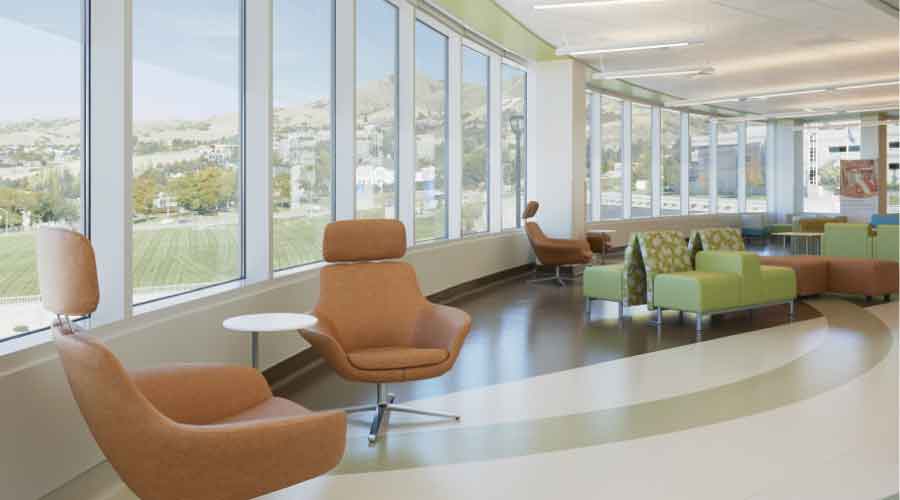Beyond Efficiency: Understanding the Occupant-Focused Benefits of Daylighting
Research shows that access to sunlight during the day has myriad benefits for the health and wellness of building occupants.
By Derrick Larm, contributing writer
While daylighting has the power to reduce a building’s energy cost, its role in the conservation of energy has been diminished. When compared to incandescent lamps, energy efficient LED lamps use less electricity and produce less heat for HVAC systems to manage. However, daylighting has shown significant benefits to individual occupant wellness that, in turn, impacts us all on a societal level. The direct link to the outdoors helps create a visually stimulating and productive environment for users while strategic furniture placement, design, and finishes further enhance their overall experience.
An integrated design approach that incorporates daylighting elements has the potential to increase the value of a space. Technical and interior design choices alike contribute to desirability. For example, including large open areas can not only open up a space to make it look larger, but the full, unobstructed views help people connect with nature and the building’s surrounding environment. Understanding daylighting and natural lighting’s daily shifts can help designers create a space that is prepared for the sun’s rays, by either reflecting or absorbing the light and heat. Each proactive element will increase the quality and value of that space.
Daylighting also has several physical and mental health benefits. Dark, unused spaces can eventually breed mold and bacteria that are dangerous for occupants to breathe in, but ample access to natural sunlight ensures a space remains lit, welcoming, and free of unwanted microorganisms or larger pests. In terms of physiological benefits, exposure to sunlight boosts Vitamin D and white blood cell production, breaks down carbohydrates, proteins, and fats, and improves one’s nervous system functions and blood pressure. Psychologically, one’s mood, morale, and sleep-quality can improve, energy levels can increase due to the suppression of melatonin, and Seasonal Affective Disorder (SAD), linked to anxiety and depression, can be reduced. These benefits, garnered by harnessing the sun’s rays and strategically designing spaces around daylighting, all contribute to an enhanced user experience and consider each occupant’s well-being.
Benefits By Environment Type
Beyond the personal benefits brought by daylighting, different industries will see varied benefits based on their location and environment type.
In office settings, work zones with ample natural lighting can increase productivity and mental performance. Considering the physiological benefits, ensuring spaces that receive heavy foot traffic are well-lit can help keep people that are in the office, either year-round or on a flexible/hybrid schedule, productive and energized. Similar to educational spaces, sun-lit areas can enhance alertness, reducing daily fatigue. These active environments where learning and collaboration take place should consider daylighting in their designs from the beginning to ensure the users are gaining the individual and group benefits naturally available to them.
As for retail locations, any elevated environment with thoughtfully implemented daylighting creates a more pleasant shopping experience for the occupant and boosts sales for the owner. A naturally lit space that appears cleaner, brighter, and more spacious increases the amount of time a customer is willing to spend in a store. Plus, a retail space that looks busy will also attract new customers, making daylighting an important consideration in the design of new retail spaces. Natural light also provides conditions for colors to appear in their truest form. Whether they’re shopping for clothes or furniture, the customer receives the ultimate benefit of purchasing a product that will look the same in store as it will at home.
The healthcare industry has the unique opportunity to capitalize on the benefits hospitals and doctor’s offices can offer to occupants by integrating daylighting in their design approach. Doctors, nurses, and patients alike can see reduced physical and mental strain, and an improvement in their overall moods and communication with one another, when given access to natural lighting. Sunrooms, green rooms, and open-ceiling concepts, in addition to enlarged windows traditionally seen in the healthcare field, are simple features that can easily increase one’s well-being while recovering, or working. Access to daylight has also proven to reduce in-patient stays by a median of almost 29 percent, as opposed to those in rooms facing away from the sun. A 2011 study by Joon-Ho Choi and associates explains how rooms oriented toward morning sunlight (between 8:00 a.m. and 1:00 p.m.) may, “have positive effects on a patient’s average length of stay (ALOS) by regulating his/her circadian rhythm naturally.”
While industrial spaces are traditionally enclosed to maintain a clean work environment, the decreased exposure to natural light is actually impacting occupants negatively. Feelings of claustrophobia and unhappiness can form in places where people feel they don’t have an escape. While the lack of windows is a metaphorical cut-off from the outside world, the enclosed space has the power to decrease productivity, impacting production costs and a net positive workflow. For the workers, their physical health is heavily affected, putting them at a higher risk for infection because they are denied a daily dose of sunlight. To safeguard these employees, developers should take the time to integrate daylighting elements—windows at the very least—that will improve their industrial working environments.
Daylighting is no longer on the mainstage for energy conservationists because the consideration of natural lighting has become an industry standard for architects and designers worldwide. While its integration will reduce energy costs, more fruitful benefits have been discovered for the occupants, pushing firms to take integrated design approaches that increase the user’s well-being while indoors. Learning to control the direct application of natural light within a space provides endless opportunities for developing thoughtful locations that achieve the goals of the clients while ensuring the occupants are given the best experience possible.
Derrick Larm is an architect and project manager with MHTN Architects in Salt Lake City, Utah.
Related Topics:












